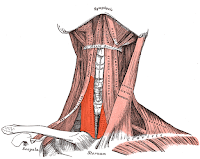The main laryngeal elevators are: Digastric anterior and posterior, the stylohyoid, mylohyoid, geniohyoid, genioglossus, hyoglossus, and thyropharyngeus muscles. (Those last three muscles will be discussed in greater detail with articulatory and pharyngeal muscles.) The Digastric muscle has two separate "bellies," or parts, the anterior and posterior. (In red below:)
The anterior belly originates from the inner surface of the mandible (or lower jawbone) and the posterior belly originates from the mastoid process. Both bellies insert into the hyoid bone at the top of the larynx. The anterior belly pulls the hyoid up and forward and the posterior belly pulls the hyoid up and back.
The stylohoid muscle originates from the styloid process and inserts into the hyoid. (Other than the diagastric, the other elevators have nifty names that help to remember origin and insertion.) This muscle elevates and retracts the hyoid when contracted.
The mylohyoid muscle quickly became my favorite muscle during (timed) lab quizzes on laryngeal elevators because it's so easy to see! This muscle originates from the side of the inner (or inside) of the mandible and fans inward to the hyoid bone, it's insertion point. (This is really the primary muscle you're massaging when you stick your thumb under your chin...but if you really dig in, you could get at some of the lower tongue muscles as well.) This forms the bottom of your oral cavity. Contraction of this muscle moves the hyoid up and forward, and it also depresses (or lowers) the mandible. It also raises the floor of your oral cavity when you're starting to swallow.
So the last elevator I'm really going to talk about in detail here is the geniohyoid. The geniohyoid muscle is located directly above the mylohyoid, so when you look at the picture below, realize that the mylohyoid has been cut away so you can see it. This muscle originates from the mental symphysis (which is the back of your chin) and inserts into, you guessed it, the hyoid bone. (I told you that hyoid bone gets a lot of play.) This muscle raises the hyoid up and moves it forward.
The other three, the hyoglossus, genioglossus, and thyropharngeus will be discussed in more detail when we get to the tongue and pharyngeal constrictors. The first two listed, though, are primarily extrinsic muscles of the tongue, but they both elevate the hyoid as well. The thyropharngeus is part of the inferior pharyngeal constrictor. It has a bigger part to play in swallowing, but it does also elevate the larynx from it's insertion into the thyroid cartilage. (Finally! One that doesn't attach to the hyoid bone!)
On to the laryngeal depressors! There are four of these bad boys we're going to talk about: The sternohyoid, omohyoid, sternothyroid, and thyrohyoid. I'll bet you $1 you know where their points of origin and insertion are right now. (Seriously, though, never take a bet from a musician. It's much more likely we actually don't have $1 to give you...) Anyways, lets roll through this guys all lickity-split like, shall we? (My apologies to my readers from outside of 1940's America.)
The sternohyoid originates at the sternum, more specifically the manubrium and the clavicle (now I'm just showing off) and inserts into the hyoid. It lowers the hyoid upon contraction.
The omohyoid (another one of my favorites during lab quizzes) has two bellies: superior and inferior. The two bellies are separated by the intermediate tendon, and as such, the superior belly originates from that tendon and inserts into the hyoid and the inferior belly originates from the scapula and inserts into the intermediate tendon. Contraction of this muscle lowers the hyoid.
The sternothyroid originates at the sternum and inserts into the thyroid bone. (Another one not hoping on that hyoid train.) It lowers the thyroid cartilage.
And finally, the thyrohyoid, which originates from the thyroid cartilage and inserts into the hyoid. (Yup, the hyoid is still a player.) Contraction ends up lowering the hyoid bone, but it can also elevate the larynx if you talk to it really nicely. (I'm getting a little punchy right now with all of this anatomy, if you can't tell. It's just a little dry going through muscles that are named so clearly, but it does make life a lot easier on exams, let me tell you!)
There they all are! The wonderful extrinsic laryngeal musculature. This is the sling of muscles that suspend the larynx in the neck. They have a whole lot to do with laryngeal posturing, or where the larynx is in the neck, and also laryngeal stability, which is a big deal for folks lacking muscle tone from a disease, disorder, or injury, but also useful for singers as well). The delicate balance of coordination between the intrinsic laryngeal musculature and the extrinsic is a vital one to keep the articulatory system from trying to be the boss-man of the whole phonation-show.
So what's up next? The physiology of this whole system, including the vibration of the vocal folds (dominated by laws of air pressure) and laryngeal posturing during singing. I might split it up into a couple of posts, so check back if I didn't cover everything in the next post.
*Resource: Seikel, J. A., King, D. W., & Drumright, D. G. (2010). Anatomy and physiology for speech, language, and hearing. Clifton Park, NY: Delmar.









No comments:
Post a Comment